
Original Link: https://www.anandtech.com/show/7106/amds-a105750m-review-part-1-the-apu-and-radeon-hd-8650g-performance
AMD's A10-5750M Review, Part 1: The APU and Radeon HD 8650G Performance
by Dustin Sklavos on June 28, 2013 12:00 PM EST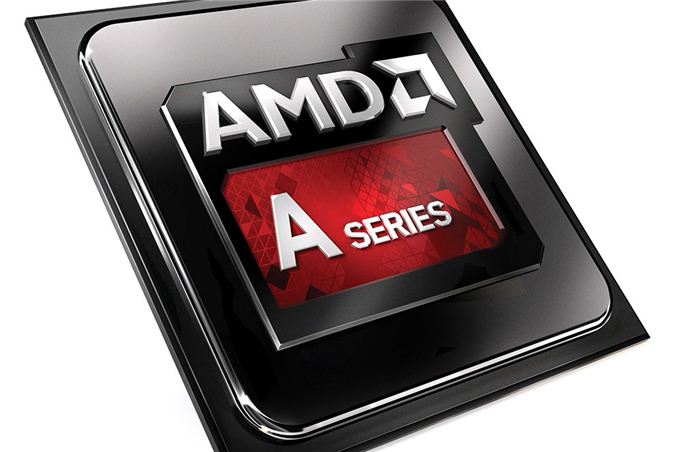
Introducing the AMD A10-5750M and Mobile Richland
As an incremental release, AMD's Richland is a little bit hard to build up enthusiasm for. Architecturally almost identical to its predecessor, Trinity, Richland's chief refinement is a substantial improvement on its implementation of AMD's Turbo Core technology. Richland is able to manage its power states with finer granularity, which allows AMD to in some cases substantially beef up the clocks that the CPU and GPU halves of the chip can hit.
On the flipside, despite the branding shenanigans going on at AMD, we're still fundamentally dealing with the same architecture as Trinity. That means one or two Piledriver CPU modules paired up with VLIW4 GPU clusters. It's a little bizarre that we saw Kabini and Temash first, since those chips marry AMD's updated Jaguar low-power CPU architecture with their current generation GCN GPU architecture; Richland is essentially old technology that's seen a healthy refinement. The market segments that Kabini and Temash serve are the fastest growing, so it's understandable, but AMD's "high end" APU architecture looks a little antiquated by comparison.
While desktop Richland has been a little underwhelming, the mobile version should have a lot more teeth. Here's a comparison, generation by generation:
| AMD A-Series Mobile APUs (Mainstream TDP) | |||||||||||||
| Model | A10-5750M | A10-4600M | A8-5550M | A8-4500M | A6-5350M | A4-4000 | |||||||
| Modules/Cores | 2/4 | 2/4 | 2/4 | 2/4 | 1/2 | 1/2 | |||||||
| CPU Clock | 2.5 | 2.3 | 2.1 | 1.9 | 2.9 | 2.7 | |||||||
| CPU Turbo | 3.5 | 3.2 | 3.1 | 2.8 | 3.5 | 3.2 | |||||||
| Graphics | HD 8650G | HD 7660G | HD 8550G | HD 7640G | HD 8450G | HD 7520G | |||||||
| GPU Cores | 384 | 384 | 256 | 256 | 192 | 192 | |||||||
| GPU Clock | 533 | 496 | 515 | 496 | 533 | 496 | |||||||
| GPU Turbo | 720 | 685 | 720 | 685 | 720 | 685 | |||||||
| L2 Cache | 2x2MB | 2x2MB | 2x2MB | 2x2MB | 1MB | 1MB | |||||||
| Max DDR3 | 1866 | 1600 | 1600 | 1600 | 1600 | 1600 | |||||||
With the new generation, everyone gets a 200MHz bump in CPU base frequency and a much more modest 20-40MHz jump in base GPU clocks. Turbo clocks jump 35MHz on GPUs across the board, nothing to write home about, while CPU turbo clocks jump 300MHz across the board. Since Trinity was chiefly CPU limited, virtually any improvement in core clocks can be a big help. What we really need is for Richland to hit and sustain turbo clocks for longer periods of time, though, and hopefully AMD's improved Turbo Core technology can make up the difference.
Unlike with Trinity, AMD didn't seed Richland reference notebooks to reviewers, so our reference unit is the updated MSI GX60. Part 2 of my review will cover the MSI GX60 specifically, but for now, here's the spec table:
| MSI GX60 (2013) Specifications | |
| Processor |
AMD A10-5750M (4x2.5GHz, Turbo to 3.5GHz, 32nm, 4MB L2, 35W) |
| Chipset | AMD Hudson-3 |
| Memory | 2x8GB A-Data DDR3-1600 (originally 1x8GB) |
| Graphics |
AMD Radeon HD 8650G (VLIW4; 384 cores; 533/720MHz base/turbo frequencies) AMD Radeon HD 7970M 2GB GDDR5 (GCN; 1280 cores; 850MHz/4.8GHz core/memory; 256-bit memory bus) |
| Display |
15.6" LED Matte 16:9 1080p LGD0259 |
| Hard Drive(s) | Western Digital Scorpio Black 750GB 7200-RPM SATA 3Gbps HDD |
| Optical Drive | TSSTCorp SN-406AB BD-ROM/DVDRW |
| Networking |
Killer Networks e2200 PCIe Gigabit Ethernet Atheros AR9485WB-EG 2.4GHz 802.11b/g/n Bluetooth 4.0 |
| Audio |
Realtek ALC892 HD audio (THX TruStudio Pro) 2.1 speakers Mic, headphone, line-in, and line-out jacks |
| Battery | 9-cell, 87Wh |
| Front Side | - |
| Right Side |
Mic, headphone, line-in, and line-out jacks 1x USB 2.0 Optical drive |
| Left Side |
Vent 3x USB 3.0 SD card reader |
| Back Side |
Kensington lock AC adapter Ethernet D-SUB Mini-DisplayPort HDMI Vent |
| Operating System | Windows 8 64-bit |
| Dimensions |
14.97" x 10.24" x 1.77" 380mm x 260mm x 45mm |
| Weight |
7.7 lbs 3.49kg |
| Extras |
Webcam USB 3.0 Card reader THX TruStudio Pro audio Killer Networks wired networking SteelSeries keyboard |
| Warranty | 2-year parts and labor |
| Pricing | $1,199 |
Without getting into the details, relevant to testing is that the GX60 actually ships with only one DIMM channel populated. While the CPU isn't heavily affected by operating in single-channel mode, the IGP takes a nearly 50% hit to performance virtually across the board. It also doesn't ship with any solid state storage, so PCMark7 is going to be heavily impacted by the mechanical hard disk. In the second part of this review, when I tackle the GX60 specifically, you'll be able to get a better idea of what the loss of that second DIMM means.
System and Futuremark Performance
While AMD's Enduro software is apparently still a mess on Intel-based systems, I actually found my only problem with it was messing with the interface to disable the MSI GX60's Radeon HD 7970M. For the purposes of isolating the A10-5750M's performance and giving it the best chance I could, I swapped in a second memory stick from the much maligned MSI GT70 Dragon Edition I recently reviewed and then disabled the 7970M.
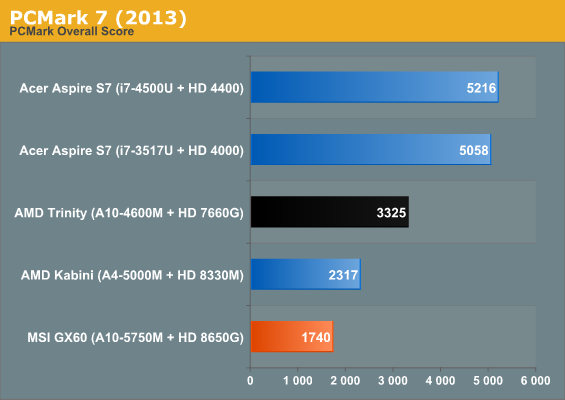
PCMark 7 is always going to respond primarily to the storage system, so the GX60's SSD takes a bath. What we want to see are scores that more directly isolate the performance properties of the A10-5750M itself.
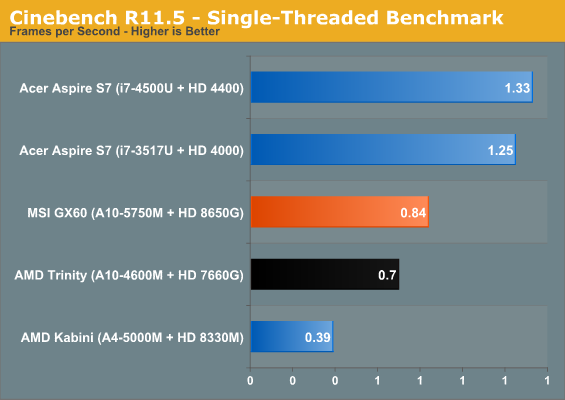
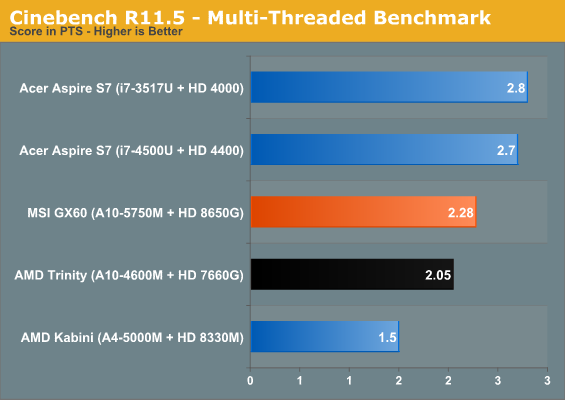
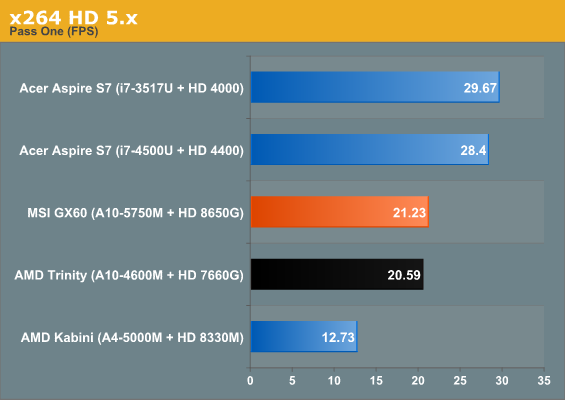
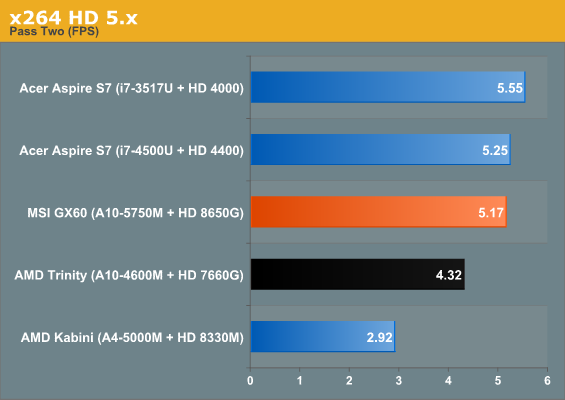
On the CPU side, we can see that Richland provides a healthy performance boost over Trinity. Only the first pass in our x264 benchmark doesn't show a notable jump, but the second pass boasts a remarkable 20% increase in performance. We're still some way from catching up to Haswell, much less Ivy Bridge, but I'll take the improvement where I can get it.
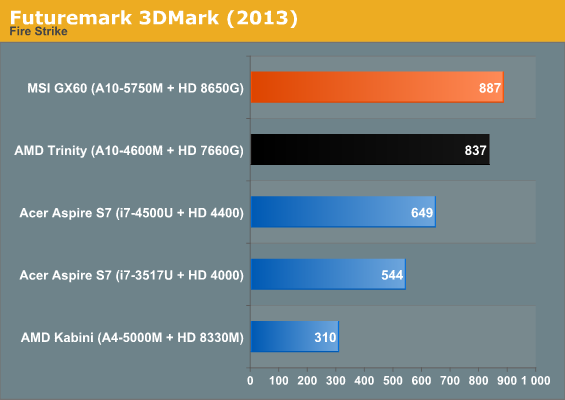
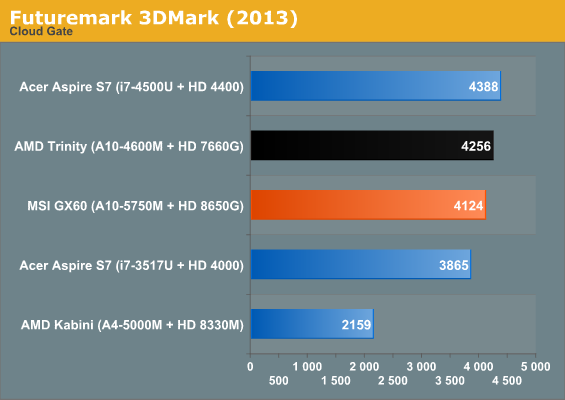
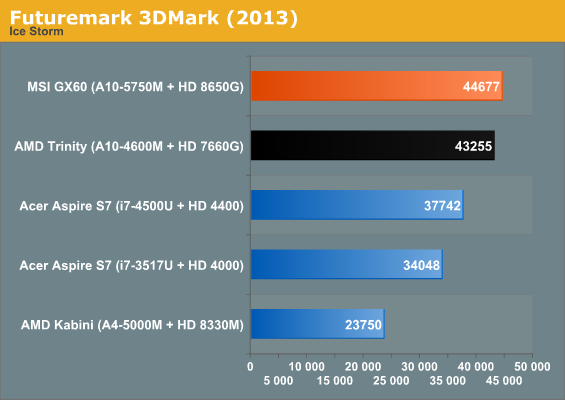
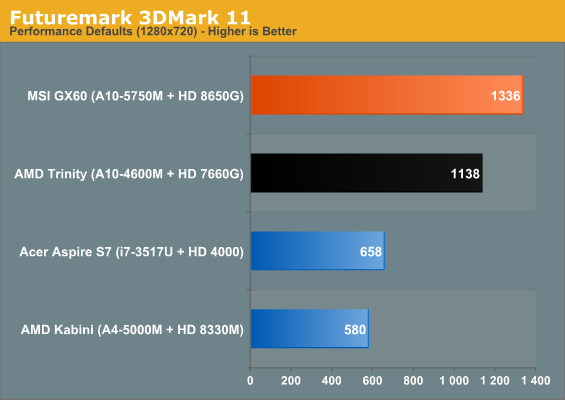
3DMark also continues to heavily favor AMD's on-die graphics, but while CPU performance got a healthy boost from Richland, the refresh doesn't move the needle on the graphics hardware nearly as much. It's generally improved apart from the odd results in the Cloud Gate test, but Richland's primary reason for being seems to be driving up CPU performance.
Gaming Performance
While I've included the Enthusiast level benchmark results in Bench, it's worth noting that Richland is still nowhere near powerful enough to handle gaming at 1080p and 4xMSAA. AMD's A10-5750M APU has two primary jobs to complete with the IGP isolated: it has to be faster than Trinity and faster than Haswell. The former is easy enough, but Haswell is more of a moving target. The only reprieve AMD seems to be getting on this front is the unusual rarity of GT3-enabled parts in the market.
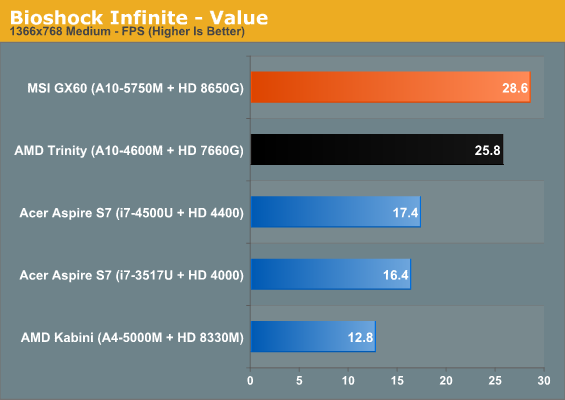
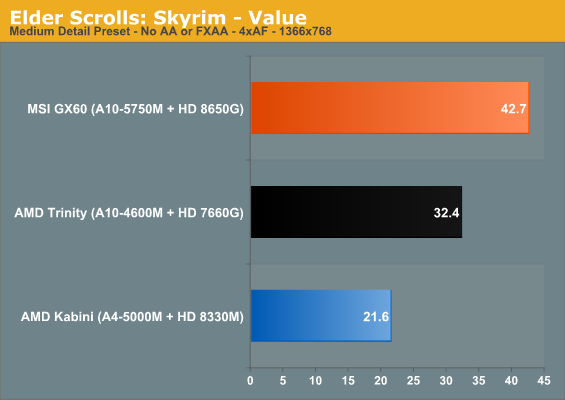
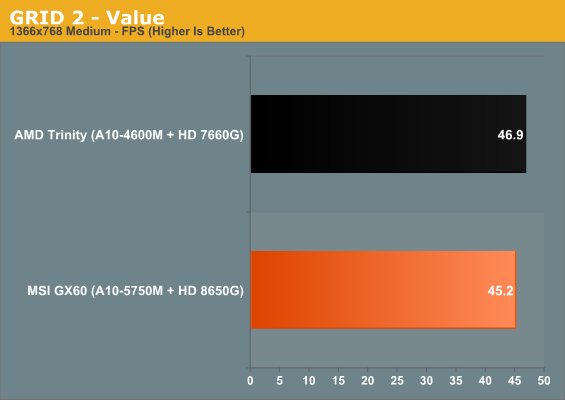
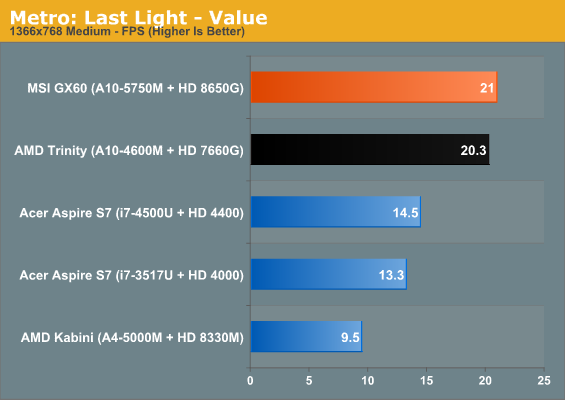
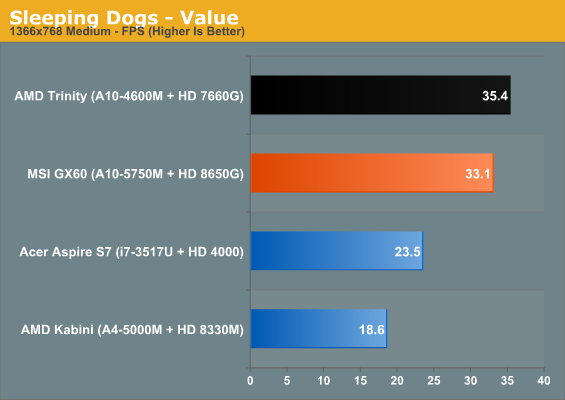
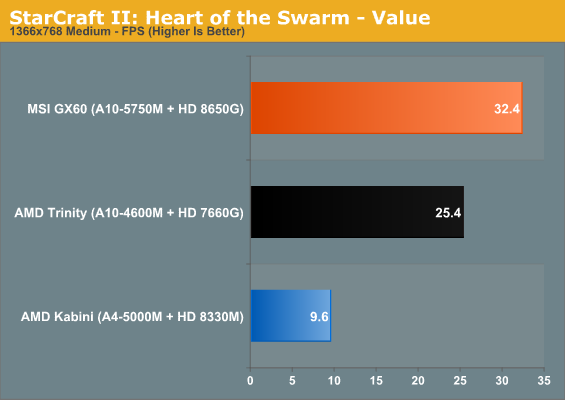
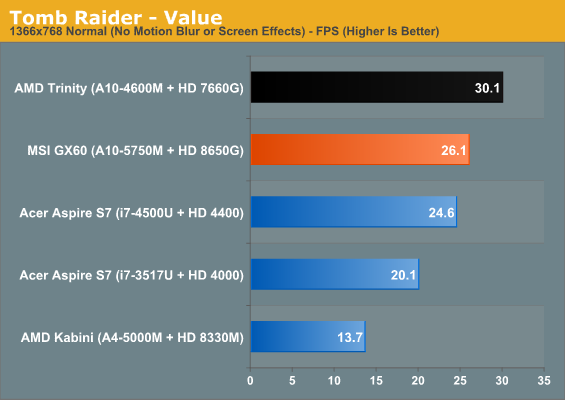
Interestingly, while Richland is consistently faster than Haswell and Ivy Bridge, often by a healthy margin, it actually trades blows with Trinity. This could be the result of either a difference in drivers or the newer version of Turbo Core being tuned to favor the CPU more aggressively. My reason for suspecting Turbo Core is boosting the CPU more frequently than the GPU is this: Skyrim and StarCraft II are both frequently CPU-limited, and both produce the largest jumps in performance from the preceding generation. Without more Richland-based notebooks to test it's going to be hard to ferret out what's going on, if this is just specific to the GX60 or if mobile Richland's turbo core really does skew more aggressively towards the CPU.
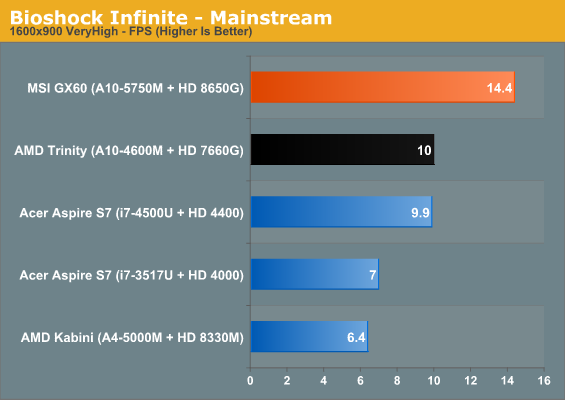
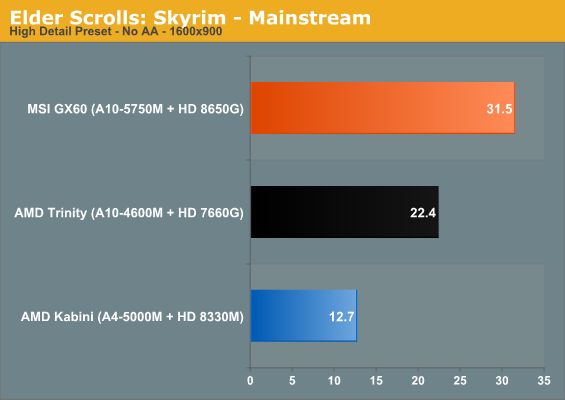
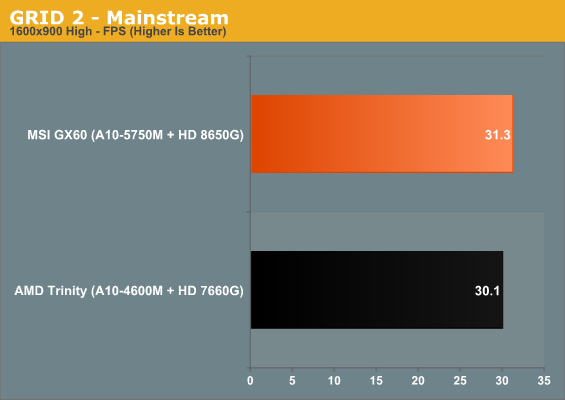
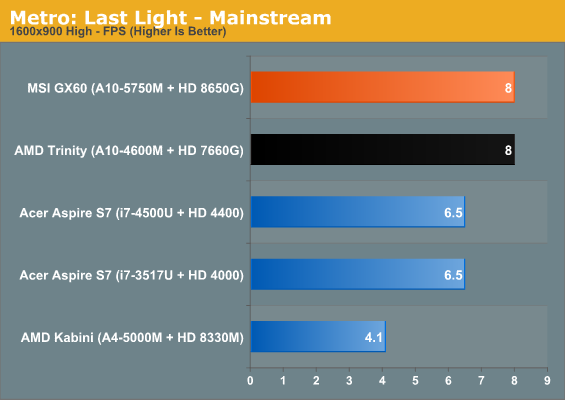
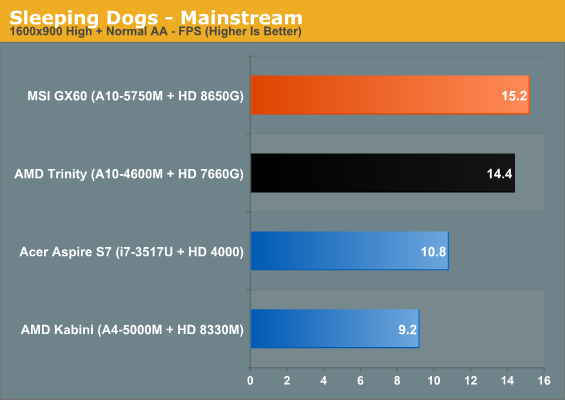
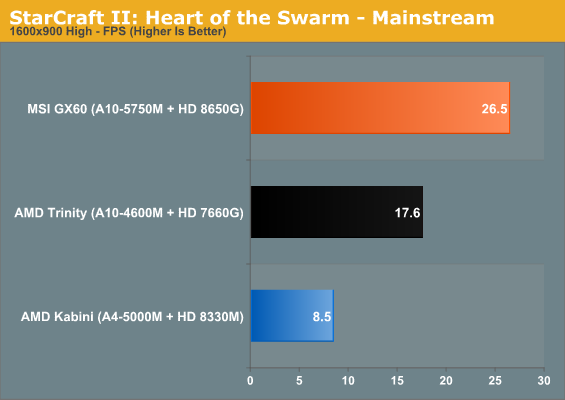
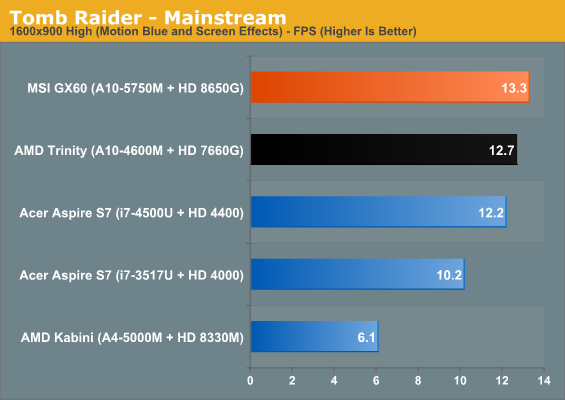
Impressively, Richland is able to produce substantial gains on Trinity in our CPU-bound benchmarks, vaulting Skyrim and StarCraft II into the realm of playability even at our Mainstream settings. Depending on the games you play, Richland could be a major improvement on the last generation.
Conclusion: Surprisingly Potent Refresh
Without getting into the nitty gritty of the MSI GX60 that houses our review APU, AMD's A10-5750M, it seems like AMD's new APU is a net victory...with some caveats.
I imagine at the time of Richland's development, graphics performance wasn't a huge concern. With Haswell, that performance target shifts a little bit, but as long as we're not heavily CPU-bound, AMD continues to offer superior mobile graphics. Richland seems to be most aggressively focused on shoring up the primary weakness of AMD's existing architecture: the CPU itself. Piledriver was a decent improvement on Bulldozer and, ironically, a mild one on Llano, but it's nowhere near enough. Bumped up clock speeds and improved turbo help close the gap at least a little bit, but we're still dealing with 35W AMD APUs struggling to hit the same performance levels at 15-17W Intel chips.
Arguably more impressive is that this refinement was possible at all. AMD was able to take Trinity, tune the silicon ever so slightly, and extract a healthy gain in CPU performance from it. Graphics performance seems to have held flat from Trinity, but an essentially free performance boost on the CPU is welcome.
I am, however, forced to address a few elephants in the room that are getting glossed over. As consumers, we need AMD to succeed. Lack of competition is showing in a major way: desktop Haswell is a joke, Haswell's GT2 IGP is a minor improvement yet promises to be the most common one in Intel's lineup, and Intel seems to be planning to mostly coast on Haswell for two years while focusing on Atom's successor.
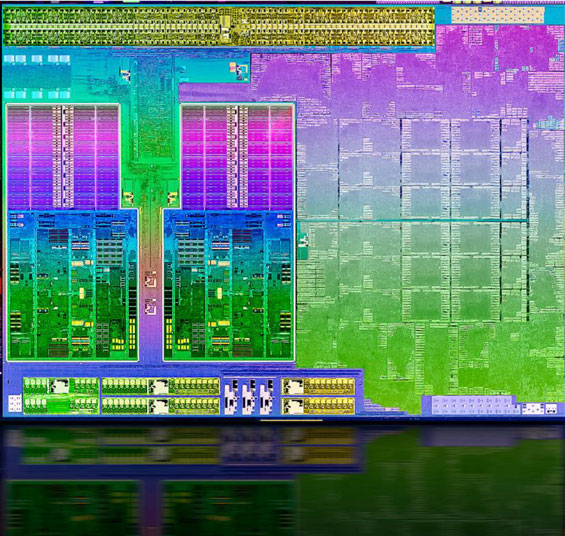
Yet the ugly truth about Richland and Trinity before them is that these reviews are covering the fastest models available. A8 chips lose a third of their GPU hardware across the board, and A6 chips lose another third. If you do some quick and dirty math, that means that anything below an A10 is going to be almost directly inferior to Haswell or Ivy Bridge. Graphics performance will at best be slightly above parity, while CPU performance takes a bath.
The other problem is that AMD is still targeting 35W as the mainstream TDP, but that's a target that's actually quietly shifted in the marketplace. This isn't 2008 anymore and Intel isn't charging a fat premium for its low-voltage hardware. The market that needs 35W CPUs is shrinking, being devoured at the low side by tablets and systems with ULV CPUs that still offer enough performance to handle the majority of tasks end users will need them for. And anyone who needs more performance than that can simply make the jump to a system with a quad-core Intel CPU that has more muscle. In this reviewer's opinion, 35W isn't the target, it's the halo. 15W-17W is the target, and while AMD has offerings at those TDPs, they're woefully uncompetitive.
AMD doesn't just need Kaveri. We need Kaveri. We need the Steamroller architecture update, and we need the graphics cores to switch over to GCN from VLIW4. Hopefully AMD will be able to produce a Kaveri part that has a fighting chance against Intel at 15W/17W, since Kabini and Temash are destined for smaller form factors. For now, the Richland A10-5750M is a good option and a solid offering for a refresh, but I don't think anyone can rely on it as a stopgap for too much longer.







